Highlights from the 2013 II Brazilian “Rochagem” Conference
From May 12-17, 2013 the Second Brazilian “Rochagem” Conference convened an impressive assembly of scientists, researchers and technicians from Brazil and around the world. Joanna Campe, Executive Director of Remineralize the Earth, was invited to speak at the conference and was given the honor of presenting second on the opening day of the event. Joanna’s presentation entitled “The Potential of Remineralization as a Global Movement” covered the historical context and current developments relating to ecological and social challenges that are being faced regionally and globally. Joanna helped open the conference to the long list of detailed case studies and presentations of the latest research on agricultural uses of different types of rock dust.
Goals of the Conference
According to the official website, the recent conference had the “goal of stimulating technological research as well as strengthening potential uses of rock dust as a mechanism for remineralization and rejuvenation of degraded soils.” For Brazil, a developing country that is the fourth largest consumer of fertilizers, whose territory is about the size of the continental United States, the efforts of federal and state governments in conjunction with the scientific and business communities seem to be paying off as the stated goal of the conference “has already become reality in different sustainable agricultural systems in different regions in the country.” After the second edition, plans have already begun for a third meeting to take place in 2016.
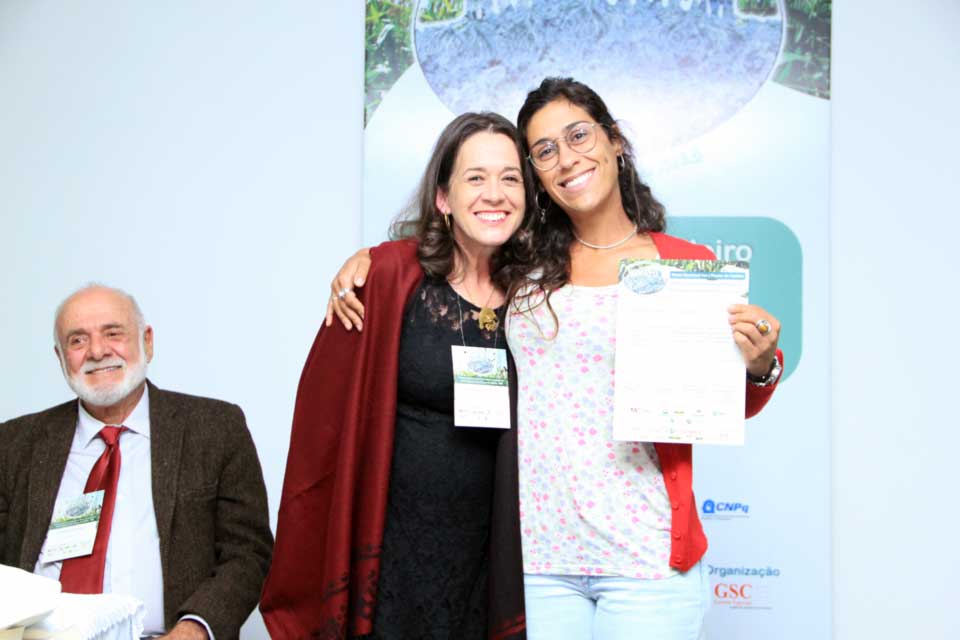
Suzi Huff Theodoro awards research prize to Fernanda de Paula Medeiros with Orthon Leonardo looking on SPECIAL EVENTS ARCHIVE GSC
In addition to giving attention to specific research on the use of agrominerals, the objectives of the 2013 conference included: evaluating and discussing advances since the first Brazilian “Rochagem” Conference in 2009, strengthening the potential of agrominerals for remineralization and revitalization of depleted soils, promoting the formation of a network of researchers and companies involved in the commercialization of rock dust, evaluating advances in relation to oversight of the use of rock dust, establishing strategies to administrate the registry and commercialization of agrominerals as a nutrient source, and publishing expanded summaries of the innovative research presented at the conference.
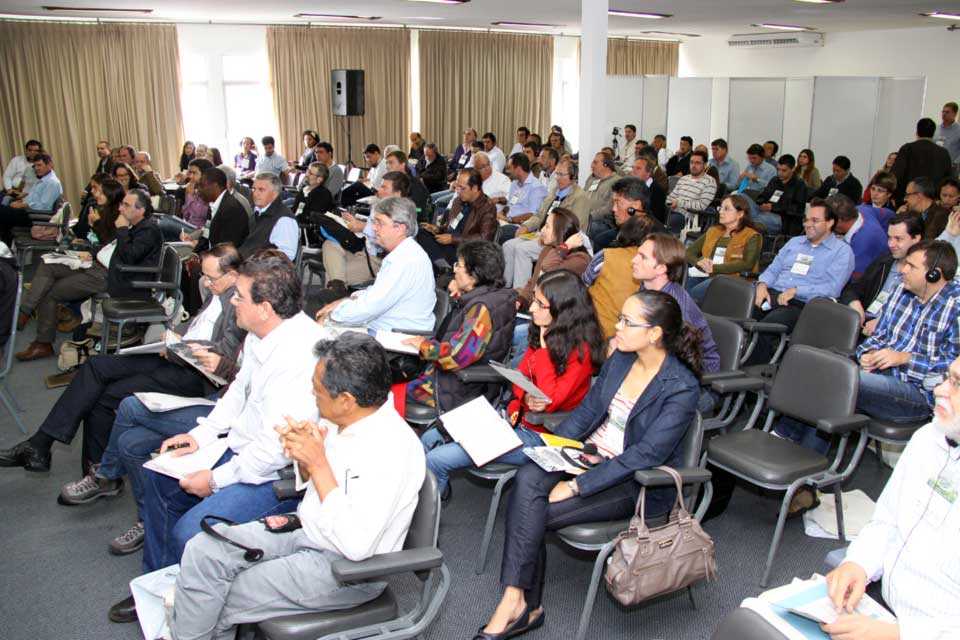
Engaged participants at the conference SPECIAL EVENTS ARCHIVE GSC
To achieve these goals, the conference called for new legislation and the establishment of a regulatory framework that will help transform research into a widespread practice. The end of the conference put a proposal that outlined standards for different types of rock dust in order to be licensed by the Ministry of Agriculture to a general vote. According to Suzi Huff Theodoro, one the conference’s chief organizers and environmental scientist from the University of Brasilia, changes in legislation are underway in the national congress. She expects that by the end of September, 2013 a proposed bill will pass through different congressional committees and be ready for Brazilian President, Dilma Rousseff, to vote on its approval.
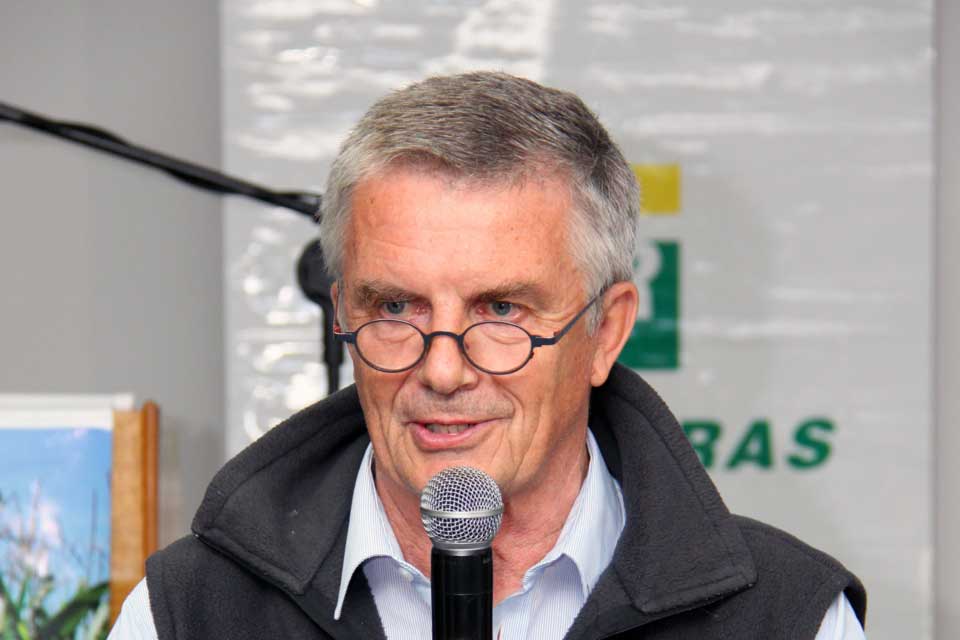
Peter van Straaten workshop presentation SPECIAL EVENTS ARCHIVE GSC
International Participants
Visiting from the School of Environmental Sciences at the University of Guelph in Ontario, Canada, Peter van Straaten gave the first presentation during the conference and helped set the tone for the five-day event. As the author of the book Rocks for Crops (2002), van Straaten has played a key role in the promotion of the use of agrominerals in Brazil. In fact, the first Rocks for Crops International Conference occurred in Brasilia, Brazil in November of 2004. As a pioneer in the field of agrogeology, van Straaten has initiated partnerships for sustainable agriculture projects across Tanzania, Kenya, Uganda, Zambia, and Canada. At the Second Brazilian “Rochagem” Conference his presentation entitled “Which Rocks for Which Crops? Ecophysiological and Geological Factors” detailed the importance of understanding “plant specific nutrient requirements during critical growth conditions as well as rock composition and release rates” in order to maximize the benefits of using rock dust for remineralization practices. In the discussion of “practical, science-based and economically viable soil fertility regeneration approaches,” Van Straaten presented agrogeological data on different sedimentary, igneous, and metamorphic rock types, as well as the release rates of specific minerals. The presentation drew on projects in African countries and made recommendations for South American countries to take an approach to remineralization practices that asks what types of native minerals would be best for specific native crops in order to “tailor the right rocks to the right crops.”
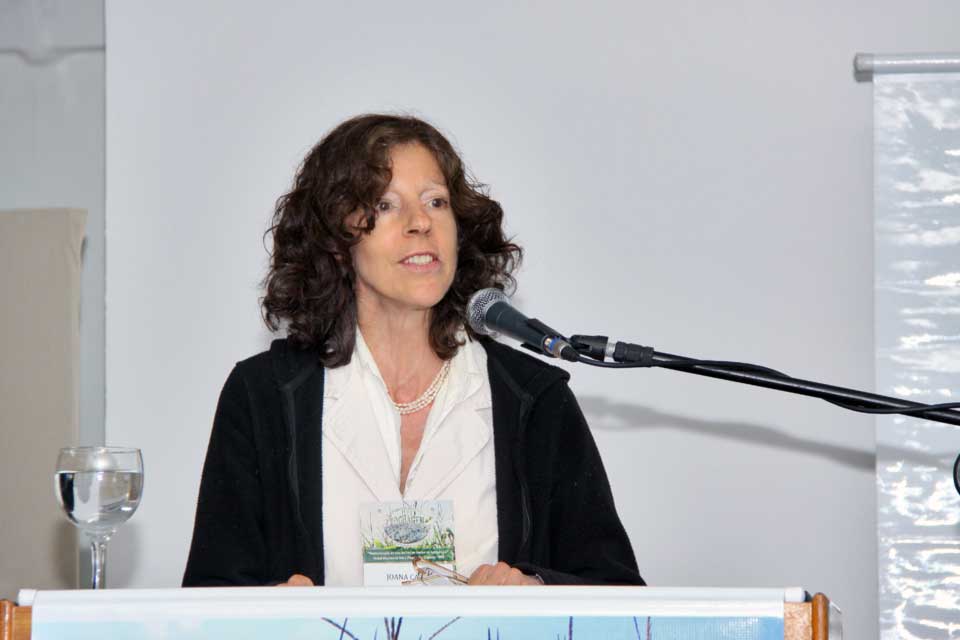
Joanna Campe from RTE SPECIAL EVENTS ARCHIVE GSC
In Joanna Campe’s presentation “The Potential of Remineralization as a Global Movement: History, current developments and potential future directions to address ecological and social challenges on a regional and global scale,” she focused on the potential to “create abundance in an era of diminishing resources and shift us away from fossil fuels.” Joanna stressed that remineralization practices can play a central role in alleviating hunger and poverty, ecological restoration, carbon sequestration, and climate stabilization, which are all important issues for sustainable development, economic empowerment, and social justice. The entire team at RTE was honored to have been represented at the conference and would like to thank the Brazilian organizers for inviting and hosting Joanna.
One of Peter van Straaten’s partners from Uganda, Vincent Kato, was invited to speak on the experience of using rocks for increased crop production in his country. His presentation, “K-Radiometric Maps; A Key Predictor Variable for Agricultural Potential Mapping: A Case Study On Bananas in Uganda,” showed how abundant and affordable rocks that contain agromineral nutrients including limestone, dolomite, marble, phosphate rocks, potassium-rich volcanic rocks, vermiculite, diatomite, mine and quarry wastes, and potassium salts, are being researched by the non-profit Agrogeology Association of Uganda (AGAU). Kato is innovating research methods by aerial mapping of potential agronomic zones using radiometric surveys that can detect radioactive waves from uranium (U), thorium (Th), and potassium (K) elements that are present in soils. Kato presented very positive results from this new method on the agrogeological mapping of K-rich areas for cultivating bananas, which is a major food crop in Uganda. He concluded that these maps “are useful in making sound decisions based on scientific information, and provide information by which K-rich rocks can be tested for the growth of high K demanding crops like bananas, fruit trees, sweet potatoes, pineapples and coffee.”
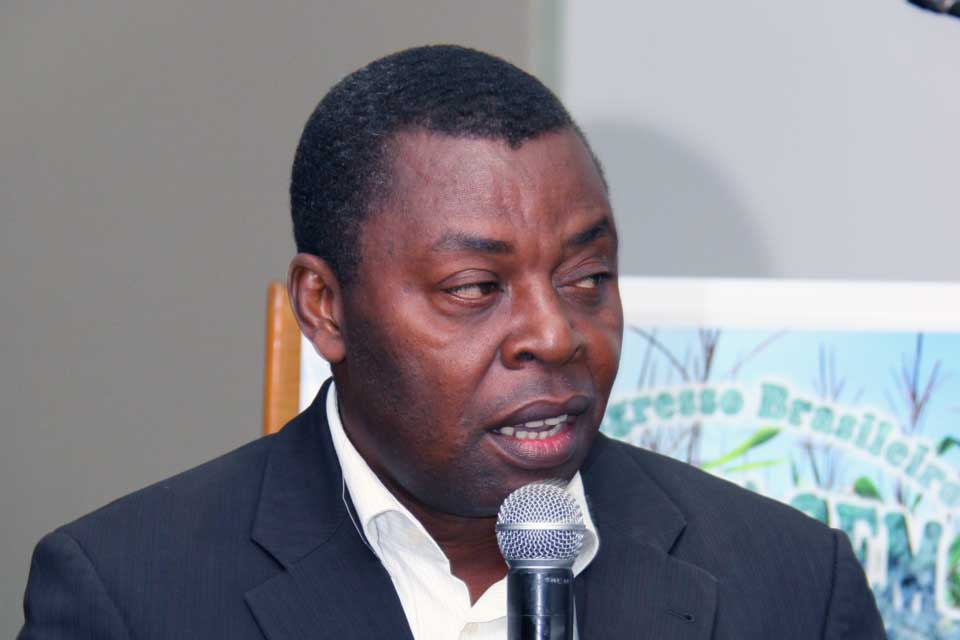
Jean-Pierre Tchouankoue SPECIAL EVENTS ARCHIVE GSC
Another speaker that presented work that is currently underway in Africa was Jean-Pierre Tchouankoue, from the Department of Earth Sciences at the University of Yaounde in Cameroon. The project Tchouankoue presented is a result of the Pro-Africa Project that consists of a partnership between Brazil, Cameroon, Angola, and South Africa. The conference’s main organizer, Suzi Huff Theodoro helped launch this project at the first conference in 2009. Presenting on “Rock Fertilizers as an Alternative to Conventional Fertilizers: The Use of Basalt from the Cameroon Volcanic Line for Maize Farming on Ferrallitic Soils,” Tchouankoue shared data and analysis from experiments using locally sourced basalt powder on corn crops. Comparing a control plot with three others containing different amounts of the mineral measurements were made of the number of leaves per stem, length of the leaves, weight of the ears, weight of dry biomass, and seed weight. In addition to uncovering the best ratios of basalt powder from different volcanic areas for corn production, the project called for continued study of low-cost ways to make basalt powder and the effects on different soils and with different crops.
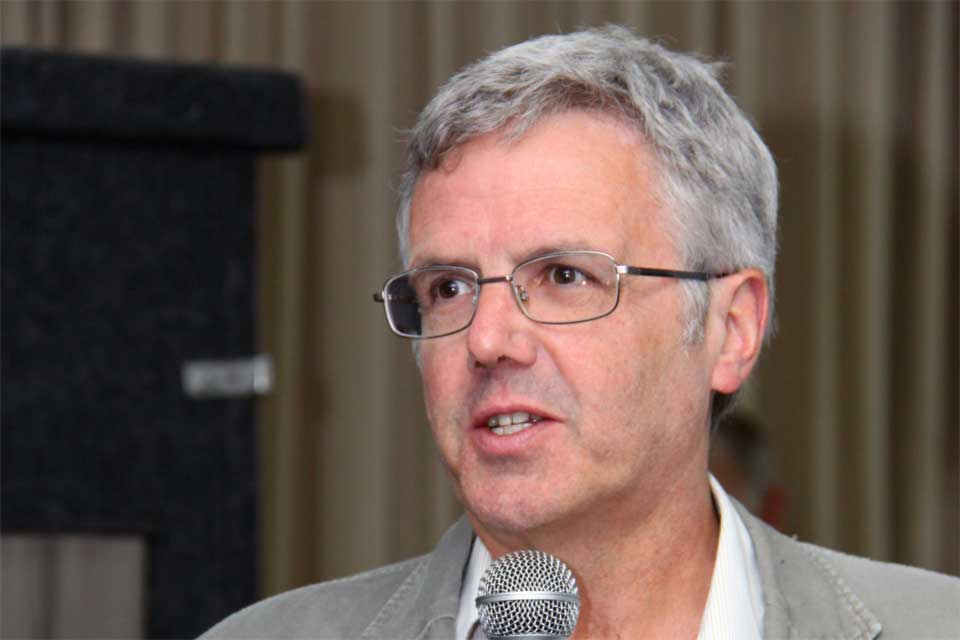
Geologist David Manning from the U.K. SPECIAL EVENTS ARCHIVE GSC
Hailing from the School of Civil Engineering and Geosciences at Newcastle University in England, David Manning presented his research whose title asked “Why Do Crushed Silicate Rock Fertilizers Sometimes Not Work?” Manning presented an explanation as to why much of the research on using crushed silicate rocks as fertilizer has produced negative results. As a professor of soil science, Manning found that “the mineralogical composition of the soil is a key factor, often not taken into account in experimental studies or crop trials.” It appears that these minerals will have little effect as a fertilizer when the soil already is largely composed of minerals derived from silicate rocks. The rate of reaction depends greatly on the equilibrium in soil and silicate rock should react more quickly in soils that are dominated by Al-Fe oxy-hydroxides. Manning concludes that “work with rock dusts needs care” and papers that generalize about these processes can be misleading.
Pioneer Researchers
One of the most important figures of the remineralization movement in Brazil is Othon Leonardos, who recently was named Professor Emeritus at the University of Brasilia. He is a very important geologist and has a profound understanding of the geochemical processes that occur in tropical climates with its specific geology. He is widely published and, since he knows Brazilian geology better than most, he has played a key role in the research coming being conducted by the group led by Suzi Huff Theodoro.
An environmental scientist and professor at the University of Brasilia, Suzi Huff Theodoro not only helped organize the conference but also authored and co-authored a number of studies that were presented during the event. One of Suzi’s projects entitled “The Effects of Remineralization Techniques and Organic Fertilizers on Tropical Soils,” presented results from extensive field experiments with five different types of rock dust in central Brazil. All five agrominerals tested produced positive outcomes and among the varying in levels of fertility and production, carbonate mica schists showed the best results. Conditions for soil fertility (pH, cation exchange capacity, and total organic C) were positively altered and the availability of macronutrients (K, P, Ca, and Mg) increased in the corn, bean, carrot, okra, and garlic crops that were studied. The second harvests produced even greater results, a fact that has garnered the attention of leading researchers from all over Brazil who are concerned with food security. “These indicators show that the use of rock dust in food production in tropical soils can not only contribute to the eradication of poverty and food security in Brazil, but also assure the production of healthy food without the use of chemical fertilizers.”
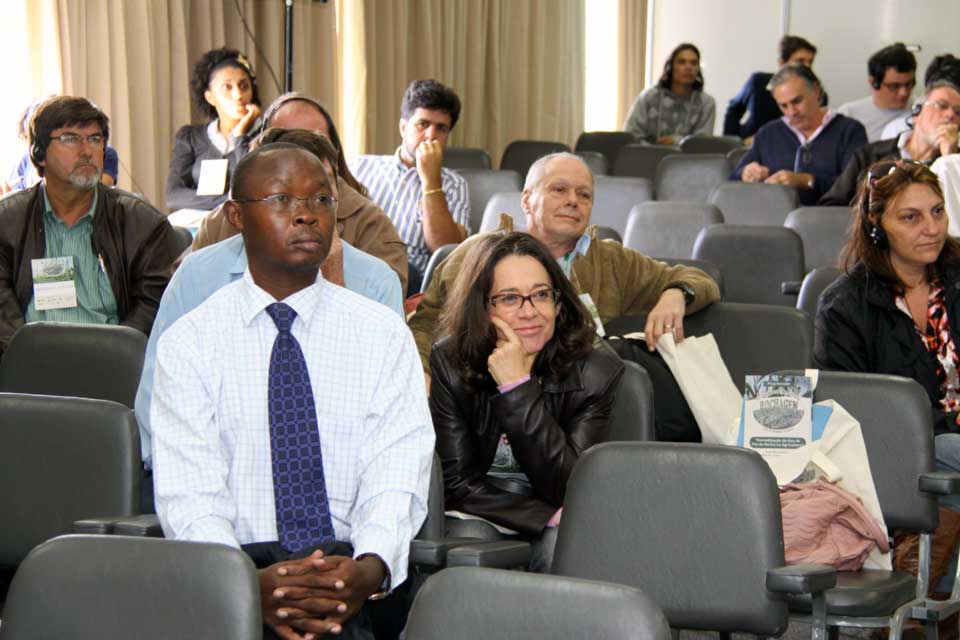
Vincent Kato and Suzi Huff-Theodoro SPECIAL EVENTS ARCHIVE GSC
Suzi also contributed to the entitled “Normalizing the Use of Remineralizers: Limitations and Perspectives.” This project analyzed the issue of Brazil’s heavy dependence on the importation of agricultural fertilizers and called for legislation to provide a regulatory framework for the commercialization of agromineral products and in order to normalize remineralization practices. Laws that regulate the use of agricultural fertilizers in Brazil have not been altered since the early 1980s and without reform “Brazil will continue to be dependent on expensive imported fertilizers that cause serious environmental damage.” Initiatives stemming from the Ministry of Energy and Mines and other public institutions are currently discussing how to change the legal apparatus. Additionally, there are efforts from within the national congress that seek to reform current legislation and promote the use of rock dust at the national scale.
Eder de Souza Martins, Geologist and lead researcher at the Brazilian Agricultural Research Corporation (EMBRAPA), also led numerous studies that were presented at the conference. Martins co-authored one study called “Challenges in Food Security and Sovereignty: The use of rock dust as an alternative and sustainable resource,” which raised questions relating to policy-making and the current state of research on remineralization. Martins highlights the creation of more sustainable systems through development of alternative nutrient sources for crops like bio-fertilizers and natural mineral resources. Since the use of rock dust promotes the exchange of cations in soils through the formation of new clay minerals and makes macro and micronutrients available, bio-fertilizers are a viable solution for soils with low fertility – a common situation for Brazilian soils.
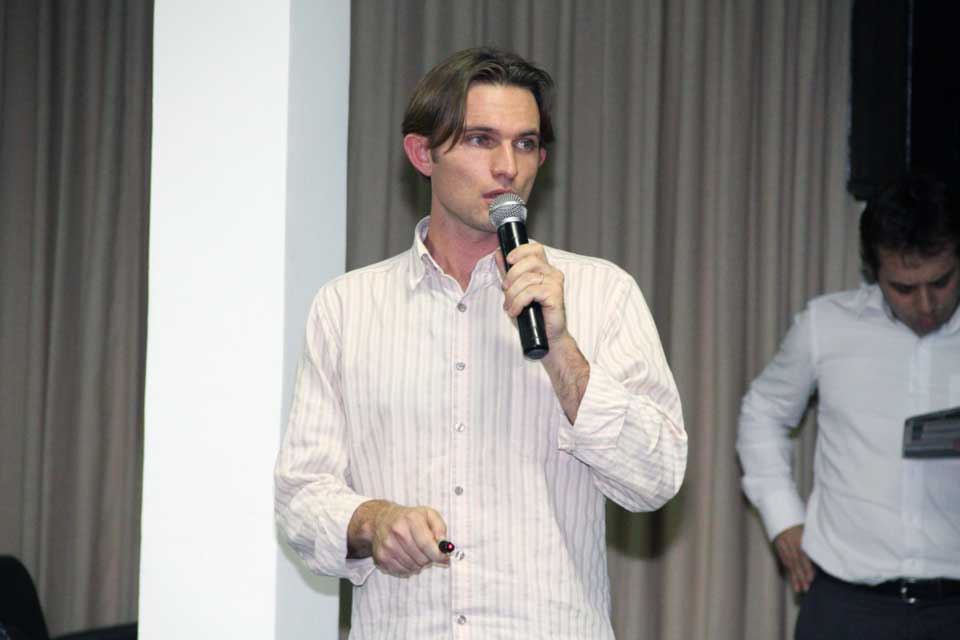
Adilson Bamberg Represents Research Team with Embrapa in South Brazil SPECIAL EVENTS ARCHIVE GSC
A New Generation
Hailing from a team of Embrapa researchers in the south of Brazil, Carlos Augusto Posser Silveira, co-authored a number of papers given at the conference with colleagues, Adilson Luis Bamberg, Rosane Martinazzo, Magda Bergmann, Matheus Farias Grecco, and Mariana de Luz Potes. One study, “The Agronomic Performance of Mineral and Organic Sources of Nutrients for Cultivation of Corn and Wheat,” challenged claims that rock dust is inefficient for agriculture and analyzed the agricultural use of a mixture of mineral and organic nutrient sources. Results showed that, contrary to the idea that rock dust is an inefficient fertilizer due to a slow release of nutrients; immediate effects were seen benefiting the first harvests of corn and wheat crops.
Geologist Magda Bergman from the Mineral Resource Research Company (CPRM), which is part of the Brazilian Geological Service, co-authored multiple studies in conjunction with Embrapa. One study, led by geologist Rosemary Hoff of Embrapa entitled “Geographic Information Systems Contributing to the Use of Rock Dust Derived from the Serra Geral Region in Areas of Wine Production” presented rock dust as a sustainable approach to develop the production of wine in Brazil. A geographic information system has been created to generate a database that can cross reference Embrapa’s data on areas of grape and wine production with data from the CPRM on agromineral sources in the same region.
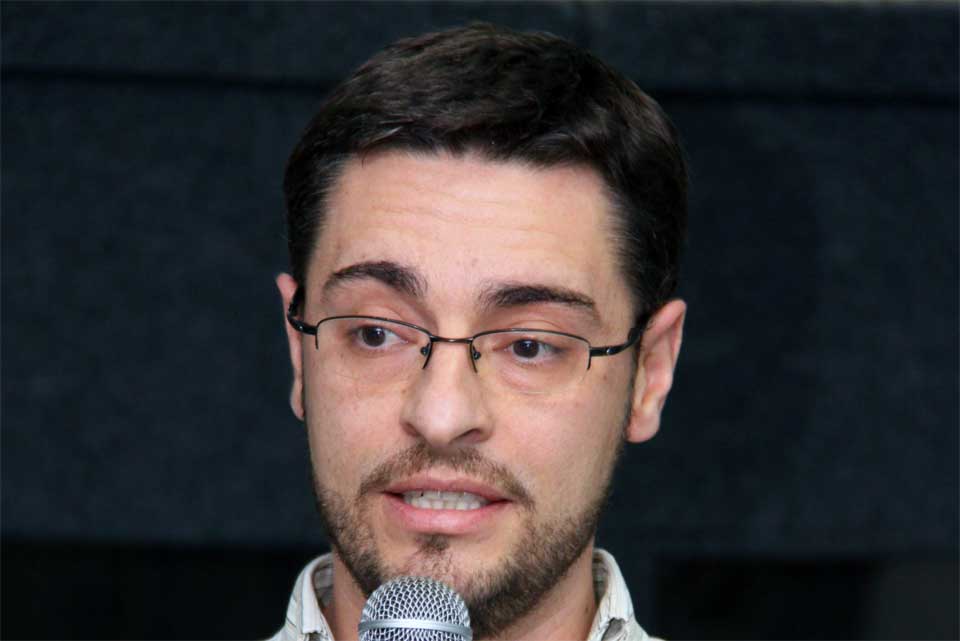
Rafael Messias Speaks About Food Security SPECIAL EVENTS ARCHIVE GSC
Brazilian food safety expert Rafael Messias presented on the “Grain Quality of Seven Types of Corn Subjected to Different Types of Fertilizer.” This case study analyzed the effects of water-soluble fertilizers vs. slow release fertilizers in six native corn types and one commercial corn hybrid. Measurements were made of total carotenoids, mineral micronutrients, starch, and sugar, which showed that slow release fertilizers (different types of rock dust) have the potential to benefit corn crops even in the first harvest when compared to soluble fertilizers.
Luana Bispo de Assis, a lawyer who is currently earning her Masters in Agrarian Law at the Federal University of Goiás participated in many of the studies that were co-authored by Embrapa’s Eder de Souza Martins. These included titles such as “The Performance of Soy with Different Doses of Basalt When Limestone Is or Is Not Present,” “The Use of Rock Dust as a Fertilizer and Soil Conditioner for the Cultivation of Sugar Cane,” “The Lack of Regulation of Rock Dust Practices in Agricultural Soil Management,” and “Economic Evaluation of the Use of Rock Dust in Commercial Farming in Southeast Goiás.” As a lawyer, her participation illustrated the emphasis that the conference placed on bridging the gap between research and practical application through transforming legislative norms.
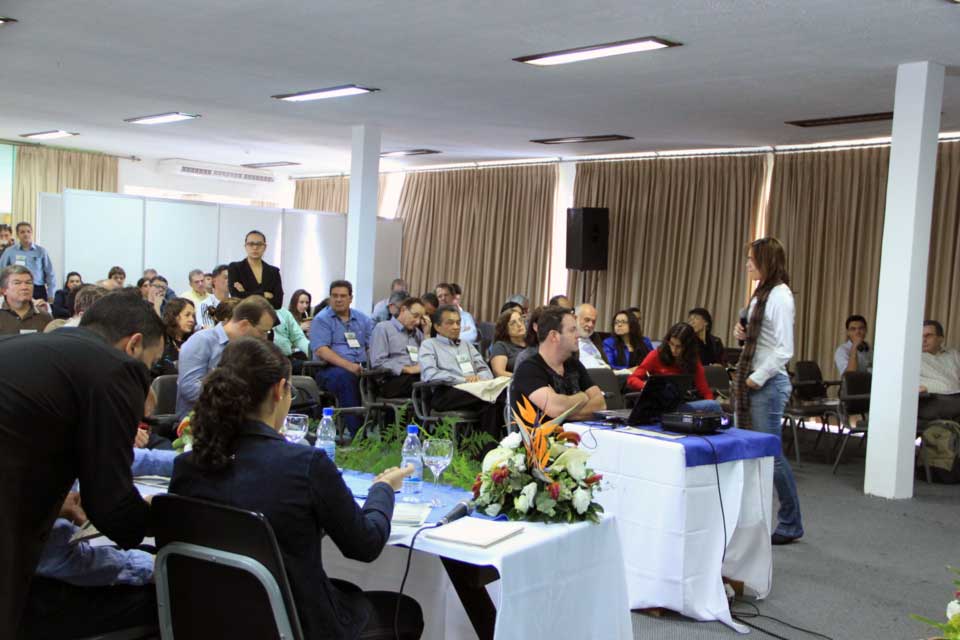
Lawyer Luana Bispo de Assis speaking on the regulatory aspects of remineralization in Brazil SPECIAL EVENTS ARCHIVE GSC
André Mundstock Xavier de Carvalho, professor at the Institute for Agrarian Sciences at the Federal University of Viçosa, presented his study entitled “Plants, Mycorrhiza Fungi, and Microbes in Soil and the Availability of Rock Dust Nutrients.” This study evaluated the role of plants, microbes, and especially arbuscular mycorrhiza fungi in the availability of mineral elements from charnockite, steatite (soapstone), and gneiss rock dust after successive harvests. Results showed that rock dust was an effective source of nutrients and did not restrict biological or fungal activity in soil. Although biological activity is important for the availability of mineral nutrients, this study showed that plants were equally capable of making nutrients from rock dust available when compared to the combination of plants with microbes or fungi.
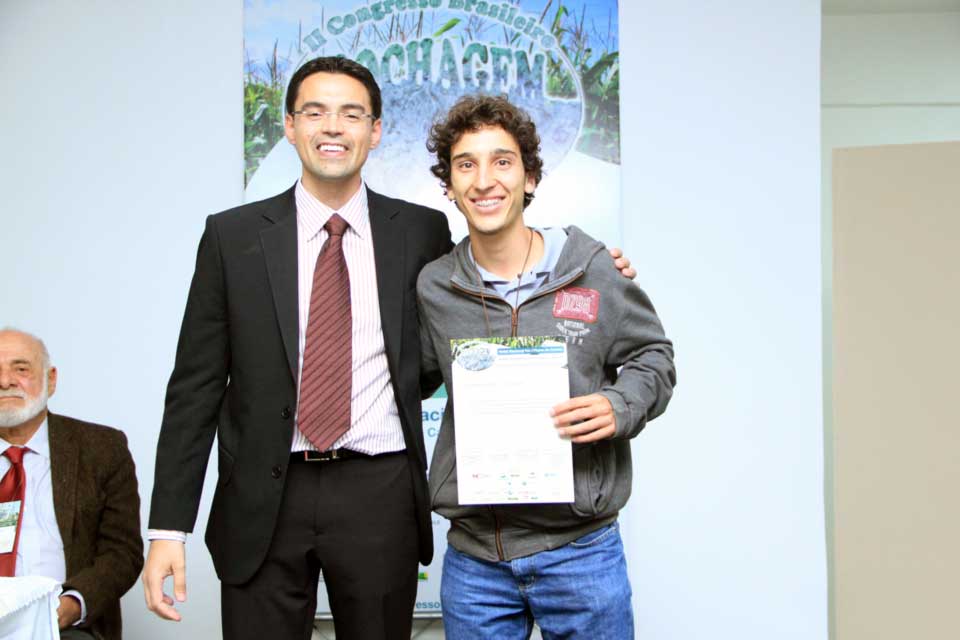
André de Carvalho Gives Prize to Caio Sampaio SPECIAL EVENTS ARCHIVE GSC
The conference held an essay contest and the two winners that were chosen are a reflection of the direction and tone of the event that is pushing to expand remineralization practices in Brazil. The two titles “Remineralization: A New Paradigm in Agriculture” by Fernanda de Paula Medeiros from the Department of Forest Engineering at the University of Brasilia and “Rock Dust for an Independent Agriculture” by Caio César Vieira Sampaio from the Institute of Agrarian Science at the Federal University of Viçosa represent the breadth of important issues, beyond increasing agricultural production, that remineralization can address in Brazil.
Lessons from Brazil
The impressive lineup of scientists from universities, government institutions, and commercial enterprises that participated in this monumental event made the Second Brazilian “Rochagem” Conference a model for other countries throughout the world. Only some of the long list of participants could be mentioned in this article, but the work of everyone in the Brazilian scientific community has placed Brazil at the forefront of remineralization technology and its practical implementation. No other country in the world can be compared to Brazil for its efforts to further scientific research and practical use of rock dust in sustainable agriculture. This is a direct result of the unprecedented cooperation between Brazilian public and private sectors.
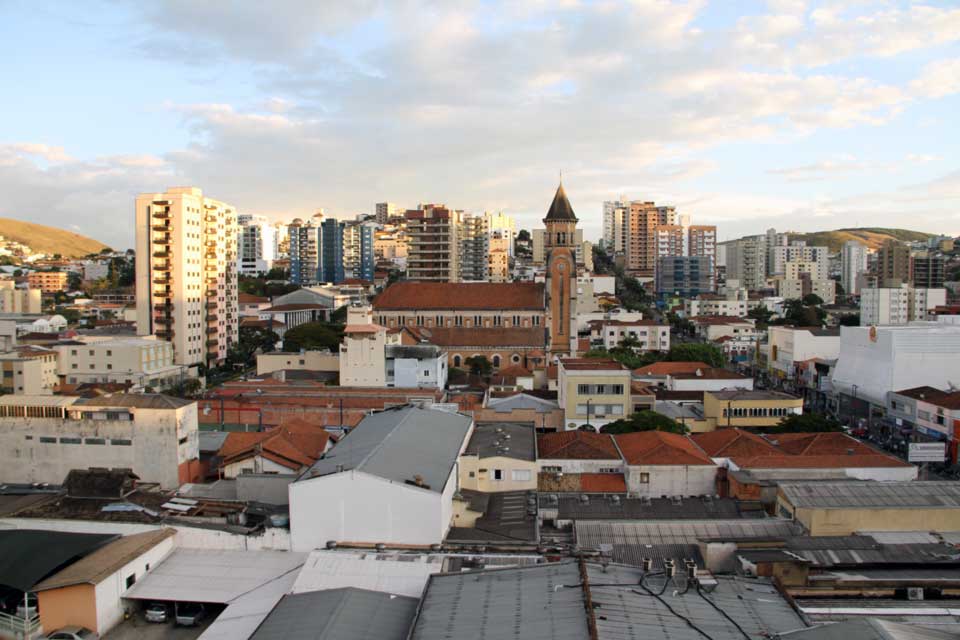
A view from the conference site SPECIAL EVENTS ARCHIVE GSC
Members of the organizing committees heralded from prestigious educational institutions in Brazil including the University of Brasilia, Federal University of Viçosa, Federal University of Lavras, Federal University of Rio Grande do Sul, and the Federal University of São Carlos. They also represented government ministries including Energy and Mining (MME); Science, Technology and Innovation (MCTI); and Agriculture, Livestock and Supply (MAPA). Other institutions linked to federal and local governments that also helped make the event possible include the Center for Mineral Technology (CETEM), the Technology Foundation Center of Minas Gerais (CETEC Minas), and the Brazilian Agricultural Research Corporation (Embrapa). Without the collaborative approach to the conference, the success of the event would have been significantly limited.
The conference’s corporate sponsor Mineração Curimbaba, which is an industry pioneer in Brazil that produces rock dust for agricultural use, hosted participants on a tour of one of their mines that produces phonolite. According to Suzi Huff Theodoro, phonolite is a rock that is rich in potassium – the micronutrient most imported by Brazil. The support from Mineração Curimbaba in addition to Brazil’s largest companies (Petrobras and Vale), demonstrates the type of collaboration that is happening in Brazil and is a clear illustration of the potential to move forward and expand the practice of remineralization in Brazilian agriculture.
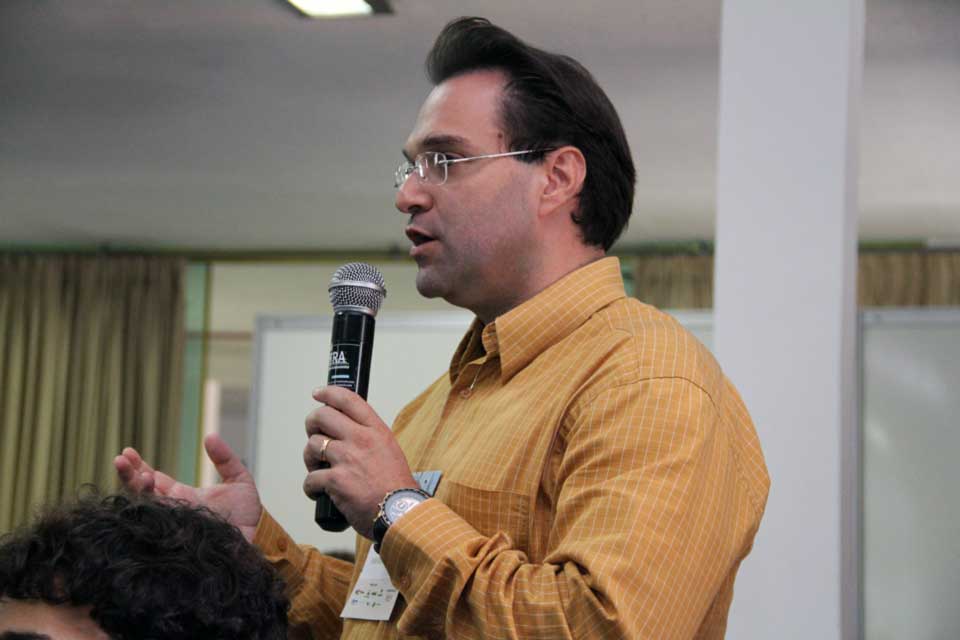
Rafael Curimbaba of Mineracao Curimbaba SPECIAL EVENTS ARCHIVE GSC
Many Brazilian rock dust companies were represented at the conference and RTE’s Joanna Campe was pleased to meet Guido Augustin Lopez Cardenas, whose company Ecostone is based in Paraguay. Son of a geologist and an agronomist himself, they have done a lot of research with their product, a gabbro rock dust they are exporting to Europe for fertilizing large organic operations such as organic greenhouse tomatoes for Biosabor in Spain. They are currently expanding to Africa and the Middle East, as well as the US.
Joanna also had the pleasure to sit down with Edinei Almeida whom Suzi Huff Theodoro introduced as a leading agroecologist in Brazil. Almeida, along with André Mundstock Xavier de Carvalho, is an extremely important scientist as his projects concentrate on the importance of remineralization for small family farms. Almeida’s work with the grassroots NGO, AS-PTA is featured in the magazine section of the RTE website. To read more about projects that help small farmers develop remineralization techniques check out this article.
Lessons from Brazil go beyond broad cooperation and collaboration among Brazilian scientists, researchers and technicians. Brazilians like Suzi Huff Theodoro, who has taken a lead role in projects outside Brazil, have reached out to the international community in order to expand innovations and the implementation of remineralization practices. Remineralize the Earth would like to congratulate the Brazilian community, specifically Suzi, Othon Leonardos, and Eder Martins on the success of the recent conference as well as the conference organizing committees, which represented several different government ministries. Suzi has played a key role in furthering RTE’s vision of addressing urgent global environmental issues through remineralization. Suzi is not only responsible for making the Second Brazilian “Rochagem” Conference possible, but she contributed directly to the publication of this article. Individuals like Suzi have enormous potential for spreading RTE’s vision and the conference should be seen as a model for other countries to adopt in order to expand the use of rock dust in agriculture and address problems of hunger, poverty, ecological degradation, climate instability, to promote sustainable development and social justice.
For abstracts, presentations and more photos go to www.congressorochagem.com.br.
RTE Staff Writer Ezra Spira-Cohen has an MA in Sociology from the PUC University in Rio de Janeiro, Brazil. He studies social movements and sustainable development in Latin America and is very interested in remineralization and sustainable agriculture.
Support us on Patreon
Thank you for joining us today! Please become a member of RTE and support us on Patreon. Unlike many larger organizations, we work with a team of determined and passionate volunteers to get our message out. We aim to continue to increase the awareness of remineralization to initiate projects across the globe that remineralize soils, grow nutrient dense food, regenerate our forests’ and stabilize the climate – with your help! If you can, please support us on a monthly basis from just $2, rest assured that you are making a big impact every single month in support of our mission. Thank you!







Got something to say?